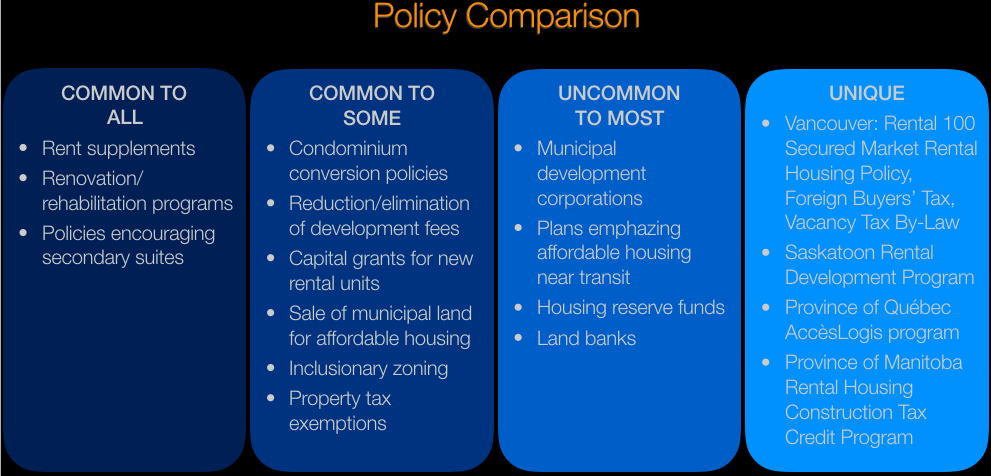Canadian municipalities have a vested interest in rental housing, and some have been very innovative in their policies, programs, and tools. While they still face obstacles to the preservation of existing rental housing, they have seen some success in developing new units, especially those municipalities who have strong relationships with their provincial government.
This is the first of a few updates I’ll be posting on a study I’m leading on the barriers and solutions to rental housing implementation in Canadian municipalities. The study was funded by the Social Sciences and Humanities Research Council and runs from 2017-2020. This update focuses on the results from Phase 1 of the study (September 2017-September 2018), in which a policy analysis and survey aimed to capture the range of policies, barriers and solutions to implementation across 15 municipalities.
Methods
The 15 cities were chosen for their population size (at least 200,000) and range of approaches to rental housing policy, plans, and programs (from minimal, standard approaches to more advanced, unique approaches). The cities range in population size from 200,000 to 4.0 million; all are Census Metropolitan Areas (CMAs) except for Mississauga, which is a Census Subdivision of the Toronto CMA. The cities can be broken down into three categories:
- Small to mid-size (200,000-400,000):Victoria, Regina, Saskatoon, Windsor, Sherbrooke
- Mid-size (400,000-1,000,000): Winnipeg, Waterloo, Mississauga, Hamilton, Halifax
- Large (over 1,000,000):Vancouver, Edmonton, Calgary, Ottawa, Montreal
Phase I of the study examined policy documents, plans, by-laws, and programs related to the provision of rental housing from the cases and their provincial governments (where applicable, e.g. in delivery of a joint program to fund new rental unit construction). A survey of municipal planners, developers, and non-profit housing developers involved in rental housing provision was then conducted (May-October 2018), and provides more firsthand insights into the municipal approaches, such as aspects of implementation or the success of key policies, which are not typically presented in publicly available documents.
Research Results
The policy analysis revealed four groups of policies: those common to all municipalities, those common to some, uncommon policies, and policies unique to a single case.

Particularly in the middle categories, there was a lot of variation in the strength of the policy and the intent of the municipality to actually implement it. For example, inclusionary zoning is a strong policy in Sherbrooke, Montreal, Vancouver, and Winnipeg, where municipal governments have had success in implementing the approach particularly in large developments requiring rezoning. Regina, Waterloo, Saskatoon, Edmonton, Ottawa, and Winnipeg are particularly advanced in their use of capital grants to support the development of rental housing, but Saskatoon offers a higher level of capital and has strong affordability requirements. A number of unique policies were found, which may be a result of the particular constraints in the municipality (e.g. Vancouver has historically seen very high housing costs and low rental vacancy rates), or unusually strong provincial-municipal collaboration (e.g. Saskatoon, Winnipeg, Montréal, and Sherbrooke). These unique policies include:
- Vancouver’ Housing 100 Policy, Moderate Income Rental Housing Pilot Program, Foreign Buyers Tax and Vacancy Tax By-Law
- Saskatoon’s Rental Development Program (in partnership with the Province of Saskatchewan)
- Province of Québec’s AccèsLogis program, which can be seen in Montréal and Sherbrooke
- Province of Manitoba’s Rental Housing Construction Tax Credit Program, which can be seen in Winnipeg
The survey contained a number of closed ended questions on the responsibilities of the respondent’s organization, their policies addressing rental housing, their success at protecting units and building new units, and their relationships with other organizations in their region as well as the provincial and federal governments. There were a total of 102 completed responses to the survey, with a response rate of 25.5%.
| Public | Private | Non-Profit | Total |
| 45 | 18 | 39 | 102 |
| 44.1% | 17.6% | 38.2% | 100% |
Some of the barriers to implementation and protection of rental housing were expected: lack of funding from provincial and federal governments, lack of resident support for higher densities and multifamily housing, and difficulty enforcing standards/policies. Other barriers raised by the participants were more surprising: lack of collaboration/communication among organizations/institutions involved in the development of rental housing and inflexible government programs. Some cities have overcome their identified barriers and seen increased cross-sector collaboration/communication, capacity building, and political will; appreciation of the need for rental housing; and introduction of incentives/tools. New federal funding is anticipated to help municipalities overcome persistent funding issues, particularly in protecting existing rental housing which has been a weak area for most municipalities.
The new National Housing Strategy, which was introduced in November 2017, is just starting to have an impact on increasing the municipal rental housing supply. In particular, the NHS is expected to play a role in preservation of existing non-profit and co-operative housing through funding for renovations and extension of existing housing agreements.
Conclusions
In summary, Canadian municipalities are taking a range of approaches to address the preservation of existing rental housing and the development of new rental housing. Some municipalities, in particular Saskatoon, Vancouver, Winnipeg, Hamilton, and Montreal have very innovative programs and approaches and stronger policy tools. Others, such as Halifax, Regina, Mississauga, and Ottawa, are less innovative and use weaker policy language. These similarities and differences will be examined further in the meta-analysis in Phase 2 of the study, with the end goal of presenting a range of successful policy tools to municipal planners, developers, and non-profit housing organizations in the Halifax Regional Municipality.
For a more in-depth discussion of the Phase 1 results, please see my presentation files.
